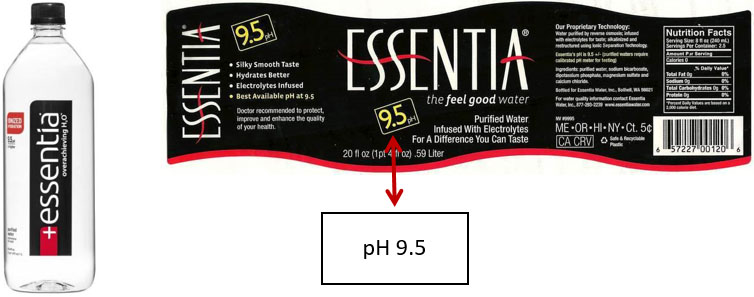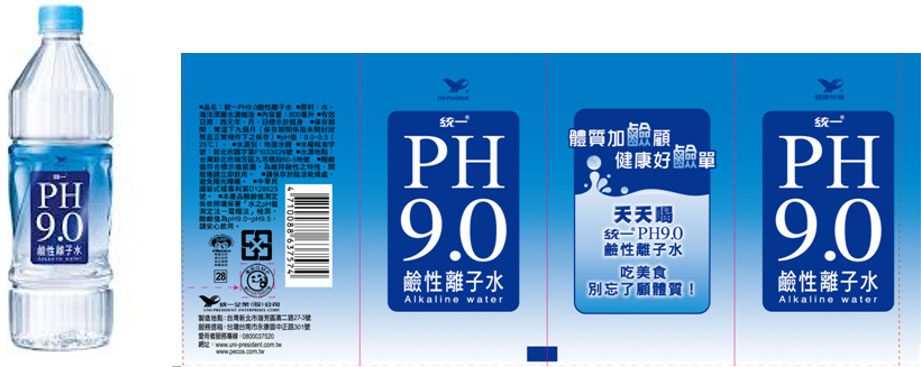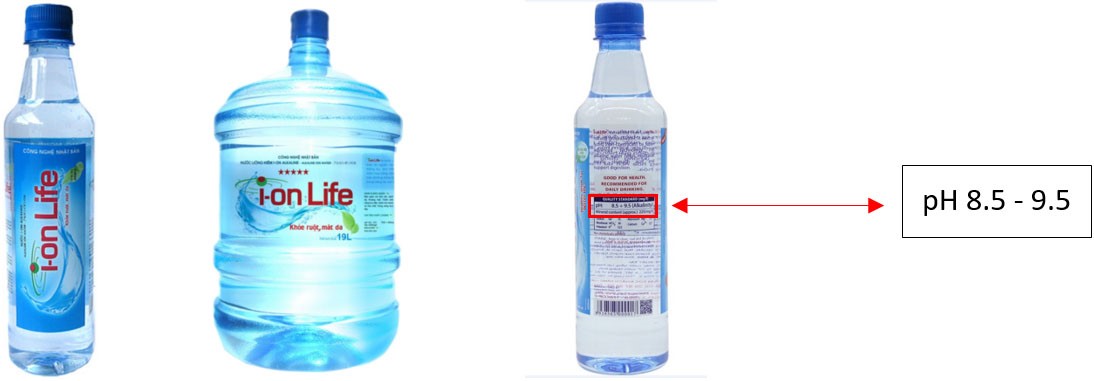 |
| 电解机能水技术领导者 |
瓶装水的pH值
国际上对自来水有pH值为6.0-8.5的限制,原因是由于自来水输送的水管可能发生管线腐蚀的问题影响水质,和可能对公众健康的影响。然而,自来水经过滤处理之后(经过滤或净化过程),这pH值的限制不再适用于自来水。
瓶装水需使用国家合格的原水,经过滤处理与消毒杀菌后再充填完成与贩卖,因此将自来水对pH值6.0-8.5的限制规定,使用在瓶装水是一种误会。
关于瓶装饮用水的pH值标准,我们乐意提供以下信息:
1. 食品法
根据“食品法”,瓶装饮用水被视为食品,因此与其他食品一样,无论pH值如何,瓶装饮用水必需是安全和可食用。
在美国,瓶装水也受到FDA的食品监管。根据FFDCA(联邦食品,药品和化妆品法),制造商有责任生产安全、有益健康和确实标示的食品,包括瓶装水产品。 FDA已在联邦法(21 CFR)第21章中制定特定的瓶装水质量标准。该指南未对瓶装水pH值有限制的规定。
按此导向FDA 21CFR完整版的连结:
https://www.accessdata.fda.gov/scripts/cdrh/cfdocs/cfcfr/CFRSearch.cfm?fr=165.110
2. 世界卫生组织
根据公布的WHO饮用水指南(第409页)表明:
「没有建议基于健康的pH值。 没有设立准则值的原因是因为饮用水没有健康的问题」。
以下链接是世界卫生组织的完整版指南:
http://apps.who.int/iris/bitstream/handle/10665/44584/9789241548151_eng.pdf;jsessionid=8CDC0D07EF25B04CC9810495536CD1EF?sequence=1
附件(1):Page 409世卫组织饮用水指南。
3. 美国FDA
此外,根据FDA政府官方网站的信息,FDA和EPA都负责饮用水的安全。 EPA管理公共饮用水(自来水),而FDA管制瓶装饮用水。
以下连结是FDA官方网站:
https://www.fda.gov/Food/ResourcesForYou/Consumers/ucm046894.htm
基于21CFR,FDA没有提及任何对于瓶装水pH值的限制,尽管EPA建议自来水的pH值为6.5-8.5。
4. 日本的法律及法规
碱性离子水是以瓶装水标准来管理,其中对瓶装水的pH值没有限制的规定。 详情请参阅日本法律翻译网站的连结。
以下连结是日本法律翻译网站:
http://www.japaneselawtranslation.go.jp/
5. 台湾法律法规(供参考)
在台湾,包装饮用水及盛装饮用水卫生标准没有对瓶装水的pH值有限制。
此外,饮用水水质标准具有pH6.0~8.5的限制,但饮用水经过滤处理后没有任何pH限制。 如在家庭或机场,学校等公共场所安装和供应饮用水的饮水机或水设备皆没有任何pH限制。
根据自来水法,自来水的pH值限制在6.0-8.5之间,这种限制的原因是因为自来水流动的水管可能会发生管线腐蚀的问题,并可能导致自来水酸化,由于输送水管可能会锈蚀或污染等,自来水可能会影响公众的健康。
然而,自来水经过滤或净化过程处理之后,pH限制不再适用于该处理后的自来水。
以下连结是台湾饮用水法律法规的完整版本:
http://law.moj.gov.tw/ENG/LawClass/LawAll.aspx?PCode=O0040019
附件(2): 台湾关于pH的法律和法规。
6. 碱性瓶装水产品正在全球的销售
众所周知,世界上大多数国家对瓶装饮用水是没有pH值限制的规定。
事实上,碱离子性水产品已在全球许多国家销售,包括美国,加拿大,澳大利亚,新西兰,欧盟国家,日本,台湾,中国和越南等。
目前销售的碱性水产品的一些例子包括(相关产品瓶标并参阅附件3):
- 美国Essentia(pH 9.5)
- 日本麒麟碱性离子水(pH 9.5)
- 台湾统一 pH 9.0
- 台湾盐(Taiyen)碱性离子水(pH 9.5)
- 越南Ion Life(pH 9.5)
7. 家用水电离器
生产pH值为8.0-9.8电解碱性水的家用电解机已在全球销售逾四十年以上。在日本和韩国,电解机已被日本和韩国卫生部授予医疗器械认证。这些家用电离器也在阿联酋迪拜销售。基于科学与医学临床认证,碱性水有效改善腹部问题(日本厚生省认证效能效果为消化不量、胃肠内异常发酵、制酸、胃酸过多等)。
附件(4):日本MOH认证家用电解机作为医疗器械(日文版)。
附件(5):韩国家用电解机认证(韩文版)。
附件
附件(1):Page 409世卫组织饮用水指南。
In the event of a spill, it may be necessary to carry out a context-specific assessment of the risk to health. The fact that petroleum products are complex mixtures of many individual hydrocarbons is a complicating factor in determining the potential risks to consumers. The traditional approach of evaluating individual chemicals in assessing the risks from drinking-water is therefore largely inappropriate. In order to overcome this difficulty, it is more practical to consider a series of hydrocarbon fractions and to determine appropriate tolerable concentrations for those fractions. The most widely accepted approach is that developed by the Total Petroleum Hydrocarbons Criteria Working Group in the USA, which divided total petroleum hydrocarbons into a series of aliphatic and aromatic fractions based on the number of carbon atoms and the boiling point, to give equivalent carbon numbers. This pragmatic approach provides a suitable basis for assessing the potential health risks associated with larger-scale contamination of drinking-water by petroleum products. The allocation of 10% of each of the reference doses, equivalent to TDIs, for the various fractions to drinking-water provides a conservative assessment of the risks. Although the approach is based on the analysis of hydrocarbon fractions, most are of low solubility, and the most soluble fractions, consisting largely of lower molecular weight aromatic hydrocarbons, will be present in the greatest concentration.
pH
No health-based guideline value is proposed for pH. Although pH usually has no direct impact on consumers, it is one of the most important operational water quality parameters (see chapter 10).
| Reason for not establishing a guideline value | Not of health concern at levels found in drinking-water |
| Additional comments | An important operational water quality parameter |
| Assessment date | 1993 |
| Principal reference | WHO (2007) pH in drinking water |
2-Phenylphenol and its sodium salt
2-Phenylphenol (CAS No. 90-43-7) is used as a disinfectant, bactericide and virucide. In agriculture, it is used in disinfecting fruits, vegetables and eggs. It is also used as a general surface disinfectant in hospitals, nursing homes, veterinary hospitals, poultry farms, dairy farms, commercial laundries, barbershops and food processing plants. 2-Phenylphenol is readily degraded in surface waters, with a half-life of about 1 week in river water.
附件(2):台湾关于pH的法律和法规。
网址:
http://law.moj.gov.tw/ENG/LawClass/LawAll.aspx?PCode=O0040019
D. Limit range of residual chlorine (Limited to water supply systems using chlorine as disinfectant):
| Item | Maximum limit | Unit |
|---|---|---|
| Free available residual chlorine | 0.2-1.0 | milligrams/liter |
E. Range for pH index (water treated by stationary continuous water supply equipment on public or private premises are not be subjected to this limitation):
| Item | Maximum limit | Unit |
|---|---|---|
| Hydrogen ion concentration index (pH value) |
6.0-8.5 | No unit |
附件(3):世界各地的碱性水产品图片。
目前市场上出售的碱性离子水
a) 美国的Essentia Water(pH 9.5)

b) 日本麒麟碱性离子水(pH 8.5 - 9.3)

网址:https://www.kirin.co.jp/company/english/about/kirinbeverage/
c) 台湾统一的碱性离子水(pH 9.0)

网址:https://www.uni-president.com/
d) 台湾台盐海洋碱性离子水(pH 8.0-9.5)

e) 越南的ION LIFE离子水(pH 8.5-9.5)

附件(4): 日本MOH认证家用水电离器作为医疗器械。

附件(5): 韩国家用水电离器认证。

 简体中文
简体中文  繁體中文
繁體中文  English
English 



